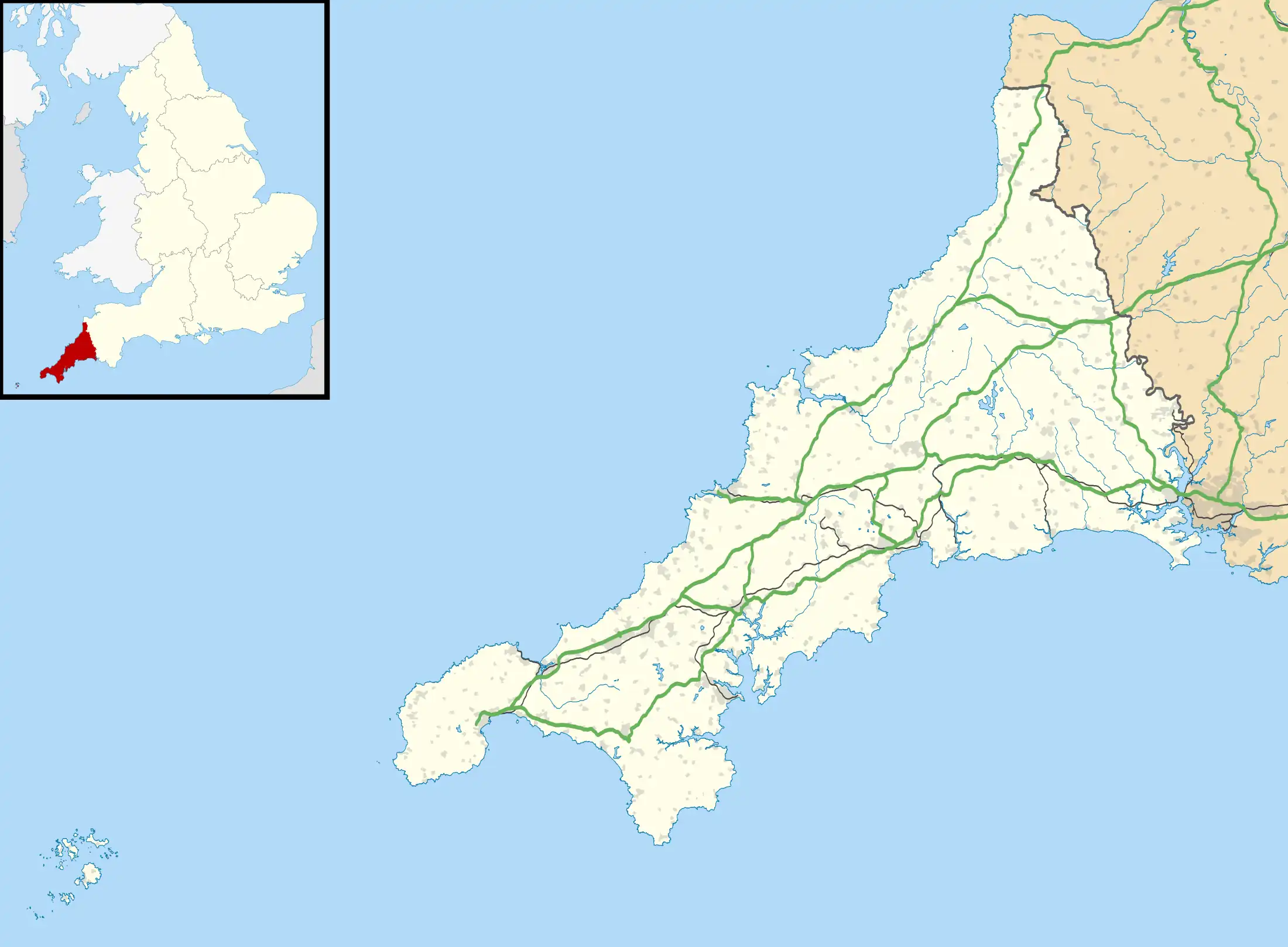| Camelford Town Hall | |
|---|---|
 Camelford Town Hall | |
| Location | Market Place, Camelford |
| Coordinates | 50°37′21″N 4°40′46″W / 50.6225°N 4.6794°W |
| Built | 1806 |
| Architectural style(s) | Neoclassical style |
Listed Building – Grade II | |
| Official name | Library |
| Designated | 19 January 1952 |
| Reference no. | 1138348 |
 Shown in Cornwall | |
Camelford Town Hall is a municipal building in the Market Place, Camelford, Cornwall, England. The town hall, which is currently used as a public library, is a Grade II listed building.[1]
History
The building was originally erected as a single-storey market house dating back at least to the late-17th century.[2] In the early 19th century, the lord of the manor and local patron, John Russell, 6th Duke of Bedford, decided to remodel the building to create an assembly room on the first floor: the enlarged structure was designed in the neoclassical style, built in rubble masonry and completed in 1806.[3]
The design involved a symmetrical main frontage facing south onto the Market Place; the central bay originally featured a round headed doorway which was flanked by two round headed windows on either side on the ground floor and there were three round headed windows on the first floor. The east and west elevations featured wide openings on the ground floor and Venetian windows on the first floor. The new assembly room on the first floor was accessed by an external staircase on the north side. At roof level, there was a timber cupola with a clock and a weather vane. The cupola contained two bells, the oldest of which had been a gift to the town from the mayor, William Prideaux, in 1699.[1] The weather vane took the form of a camel despite the fact that the name of the town was actually derived from the Brythonic name of the river, "Allen", in combination with "cam" which means crooked and the English word "ford".[4][5]
Camelford had a very small electorate and a dominant patron, William Vane, 1st Duke of Cleveland, which meant it was recognised by the UK Parliament as a rotten borough.[6] Its right to elect members of parliament was removed by the Reform Act 1832,[7] and its borough council, which had met in the town hall, was abolished under the Municipal Corporations Act 1883.[8] In the late 19th century and early 20th century the building continued to serve as the venue for petty sessions and county court hearings.[2][9] The building was subsequently transferred to a specially formed entity, the Camelford Town Trust, and stained glass displaying the former borough coat of arms was made at the expense of the clerk to the trust, Thomas Edwin Wakefield, and installed in the west-facing Venetian window in 1933.[2]
In 1975, the trust decided to convert part of the ground floor and the whole of the first floor into facilities for the county library: the works were carried out to a design by the county Architect, Alan Groves,[10] and the rest of the ground floor was subsequently converted into an office for the charity, Age Concern.[11] Restoration work carried out in the early 21st century included the re-gilding of the weather vane in 2000.[12] The management of the library was transferred from Cornwall Council to Camelford Town Council in March 2018[13] and, after additional refurbishment works, a community hub opened in the building in April 2018.[14] Princess Alexandra visited the building and saw the completed works during a visit to Cornwall on 31 July 2018.[15]
References
- 1 2 Historic England. "Library (1138348)". National Heritage List for England. Retrieved 21 December 2021.
- 1 2 3 "Camelford Town Trail" (PDF). Visit Camelford. Retrieved 21 December 2021.
- ↑ "Historic characterisation for regeneration: Camelford" (PDF). Camelford Town Council. 1 September 2005. p. 31. Retrieved 21 December 2021.
- ↑ Mills, A. D. (9 October 2003). A Dictionary of British Place-Names - A. D. Mills. ISBN 9780191578472. Retrieved 2 November 2015.
- ↑ Redding, Cyrus (1842). "An Illustrated Itinerary of the County of Cornwall". How and Parsons. p. 41.
- ↑ "Parliamentary Reform Bill, For England". Hansard. 30 May 1832. Retrieved 21 December 2021.
- ↑ "The History of Politics: The Rotten Boroughs of England". Julia Herdman Books. 21 April 2017. Retrieved 21 October 2019.
- ↑ Municipal Corporations Act 1883 (46 & 46 Vict. Ch. 18) (PDF). 1883. Retrieved 21 December 2021.
- ↑ Report of the Commissioners Appointed to Inquire into Municipal Corporations not subject to the Municipal Corporations Act. H. M. Stationery Office. 1880.
- ↑ Harrison, Kenneth Cecil; Atkins, Robert F. (1987). Public Library Buildings 1975-1983. Library Services. p. 48. ISBN 978-1870144001.
- ↑ "Cross Group Working Party Review of Cornwall Library Service" (PDF). Cornwall Council. 1 March 2010. p. 4. Retrieved 21 December 2021.
- ↑ Neale, John (2011). Following the River Camel. Amberley Publishing. ISBN 978-1445600192.
- ↑ "Camelford Town Council prepares for library takeover". Bude and Stratton Post. 1 March 2018. Retrieved 21 December 2021.
- ↑ "Camelford Library re-opens as a community hub". The Holsworthy Post. 13 April 2018. Retrieved 21 December 2021.
- ↑ "Buckingham Palace". Court Circular. 1 August 2018. Retrieved 21 December 2021.